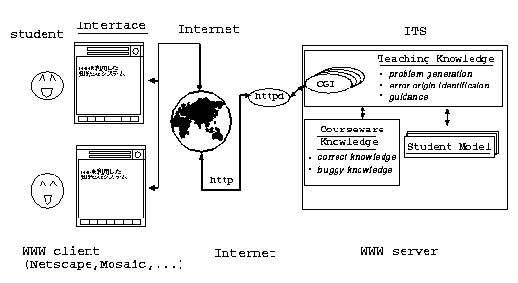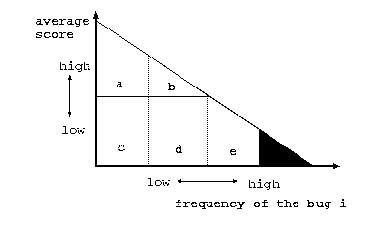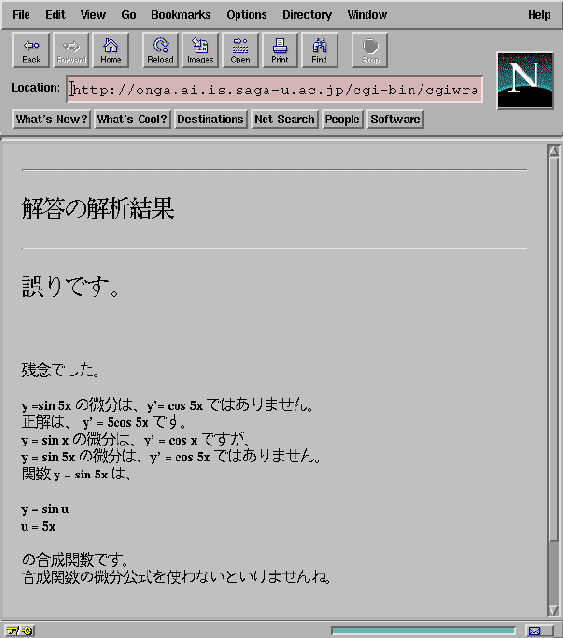
Abstract. This paper describes a WWW based ITS(we call ``WITS'' in short) for guiding differential calculations at high school. The basic structure of the WITS follows a standard ITS. All modules of the WITS are constructed on a WWW server except interface, that is implemented with a WWW client. The individualized tutoring mechanism is accomplished by combination of CGI(Common Gateway Interface) and FOF(Fill-Out Form) facilities of the WWW and user modeling technique on ITS technology. Distinctive features of our system are (1)user's (students') error origin identification based on buggy model, (2)student's state classification based on score and frequency of the bug, (3)teaching paradigms' selection based on classified student's states, (4)individualized guidance message generation and (5)adaptive KR message generation in the WWW framework. The advantages of the WWW for an ITS are that a user can access to the system from anywhere on the Internet without any special interface programs. Although the WWW framework causes some limits especially in its interface, it brings an ITS great benefit.
Many schools in Japan have started to join in the Internet [1]. Educational use of the Internet has been expected to bring new educational environments and tools in classroom[2].
The World-Wide Web(WWW) is one of the most popular technology on the Internet in school. We have proposed an application of the WWW in school as a platform for an educational system[3]. Although there are many proposals and experiments on building educational systems of the WWW framework [4,5,6,7,8], they lack error origin identification mechanism that is one of essential mechanisms for highly individualized tutoring.
We have integrated the WWW with ITS[3,9] and implemented a WWW based ITS(we call ``WITS'' in short) that guides each student based on his error origin.
Our system is a WITS for guiding differential calculations at high school level[10,11]. Distinctive features of our system are that it identifies student's error origin by buggy model[12] and classifies student's states based on his scores and frequency of the bug (See section 4.5). It realizes individualized tutoring by generating Hyper Text Markup Language(HTML) documents dynamically based on each student's state.
The advantages of the WITS are that a user can access to the system from anywhere on the Internet without any special interface programs.
In this paper, we describe our WWW based ITS(WITS) for guiding differential calculations. In section 2, we present architecture of the WITS. We explain individualized tutoring mechanism in the WWW framework in section 3. In section 4, we describe features of our system and how it works. We evaluate our system in section 5. Section 6 gives summary and future works.
We show architecture of the WITS in Figure 1. The WITS adopts CGI and FOF facilities for interactive communication between a user(student) and the system. Since these facilities are very common in the WWW framework, only a WWW client is required to use it.

Figure 1: Architecture of the WITS: The system consists of teaching knowledge that is expressed as CGI scripts, courseware knowledge, student model in server side and interface implemented by WWW clients. Teaching knowledge dynamically generates HTML documents based on user's(student's) current input and his student model.
<FORM METHOD="post" ACTION="/cgi-bin/ITS/quit"> <INPUT TYPE="HIDDEN" NAME="username" VALUE="okaz@ai.is.saga-u.ac.jp"> <INPUT TYPE="submit" VALUE="no"> </FORM>
After the system recognizes a user, all HTML documents continue including the user identifier. This user identifier is registered by the user and protected by the password.
This mechanism enables user management in the WWW server and to apply the standard ITS student modeling method. Combining CGI facility on the WWW with user modeling technique on an ITS realizes flexible and individualized tutoring on the WITS(Figure 2).

Figure 2: Individualized tutoring mechanism in the WWW framework: The teaching knowledge that is expressed as CGI script analyzes the user identifier and updates the student model file if necessary. Teaching knowledge decides teaching paradigms and generates an individualized message based on the student state and courseware knowledge. The output follows HTML format so as to be presented via a WWW client. The system embeds the user identifier in it for user identification
Our system is designed for high school students who have learned differential calculations in classroom lessons in school[13]. It has two modes corresponding to the purposes of its use. The one is practice mode and the other is remedy mode. The system consists of fixed HTML files(54 files, total 140 KB), CGI scripts(49 files, total 22 MB) and plain text data files. Nine of them are teaching knowledge which is implemented by SICStus Prolog Release 3. Other scripts are B shell scripts on UNIX. We use UNIX workstation(Sun Microsystems SPARCstation 5) for WWW server machine.
The main features of our system are as follows:
Our system works as follows:
Processes of differential calculations can be seen as sequential application of mathematical operations. We call this knowledge unit as ``tactics''. The tactics, which reduces an expression INPUT to an expression OUTPUT by using operation named TACTICS, is expressed by the following Prolog predicate,
tactics(INPUT,OUTPUT,TACTICS,CB).
The variable CB represents that the operation is correct or buggy.
This representation enables the system to simulate solving processes of human being and it is useful for student modeling and guidance. Our system has 12 kinds of tactics in the courseware knowledge.
Here we present how the system identifies the error origin. We adopt ``buggy model''[12] that is one of the standard modeling method for error origin identification in ITS technology.
For example, differentiating function ``'' is ``'' is expressed by the following buggy knowledge named ``[formula-7,bug-1]'':
The last ``b'' indicates this is buggy knowledge. Buggy knowledge is expressed by same form as correct knowledge.
We have carried out field researches in high schools and analyzed about 400 errors[14]. The most errors except slips can be explained by buggy knowledge. Our system has 13 buggy knowledge that includes all buggy knowledge in [14].
Our system classifies student's states by the error origin(bug), its frequency and average score. The frequency of the bug is expressed in a Prolog list form "[BugName,[A,M]]", where the variable BugName represents the name of bug, the variable A represents how many times the student has made mistakes in this origin and the variable M represents total problem number in which the student has be possible to make this bug.
As the frequency of the bug becomes higher, the average score becomes lower. Thus the student's state is in the triangle region of the frequency of bug i and average score space.

Figure 3: Student's state classification: student's state of each region expresses the following state;
a: almost understanding state d: state in tendency of making this bug b: little unstable state e: state in liability to make this bug c: state in tendency of making another bug f: misunderstanding state
| Teaching Paradigm | Student's state | |||||
|---|---|---|---|---|---|---|
| a | b | c | d | e | f | |
| Correct or error point out | o | o | o | o | o | o |
| Correct answer exhibition | o | o | o | o | ||
| Error origin explanation | o | o | o | |||
| Formula explanation | o | o | ||||
| Solving process explanation | o | |||||
When a student makes an error, the system presents a guidance message. Teaching knowledge module has guidance message patterns for each bug, each teaching paradigm and each student's state. Teaching knowledge module generates guidance messages by embedding appropriate expressions into the patterns. The appropriate expressions are generated by using courseware knowledge (Figure 4).
Abstract KR(Knowledge of Result) message is the message to encourage a student. The system presents this message at the end of a period of study The system selects some of the 6 topics, which are ``this time study record'', ``this time score'', ``achievement'', ``error tendency'', ``next study step'' and ``encouragement'', according to the student model, and generate an appropriate message.
| very good | good | average | below average | poor | |
|---|---|---|---|---|---|
| Response | 0 | 8 | 6 | 5 | 1 |
| Contents of guidance | 10 | 4 | 7 | 1 | 0 |
| Use of language | 7 | 6 | 5 | 0 | 1 |
The response of the server is fairly well. The reasons are that the amounts of data are little (they are plain text and less than a few Kilo bytes), data exchange between the WWW server and the client is not so often and quick response of the WWW server owing to simple student's diagnosis and tutoring mechanism. The response depends not only the server but also the network. Although multimedia such as video and audio may be useful, it would lose its effects when the system keeps a student waiting long.

Use of language also has room for improvement. Our method is likely to generate same or similar messages repeatedly to the same student. It is necessary for discourse mechanism to generate flexible and situated messages.
The advantages of the WWW for an ITS are that a user can access to the system from anywhere on the Internet without any special interface programs. Although the WWW framework causes some limits especially in interface, the WITS is an effective ITS with the advantages of the WWW.
Future works include another use of student's data gathered in the WWW server and application to another courseware. The former contains (1)construction of average student model and (2)sharing mechanism of student model between other educational systems on the Internet. The latter contains (1)definite separation of teaching knowledge from courseware knowledge and (2)making generalized CGI scripts for a WITS. At present, our system is too specialized to apply another courseware. We also need to settle the problems of limitation of HTML format and teaching paradigms decision to be our system in practical use. After these improvements, we are going to evaluate our system in the real educational field.